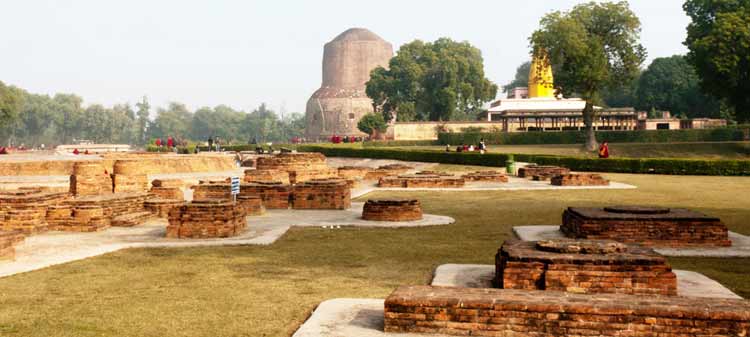Sankat Mochan Hanuman Temple is a Hindu temple in Varanasi, Uttar Pradesh, India and is dedicated to the Hindu God Hanuman. The temple was established by famous Hindu preacher and poet saint Sri Goswami Tulsidas in the early 16th century and is situated on the banks of the Assi river. The deity was named "Sankat Mochan" meaning the "reliever from troubles".[1]
Sankat Mochan Hanuman Temple
संकट मोचन हनुमान मंदिर
Sankat Mochan temple entrance, Varanasi - IRCTC 2017 (1).jpg
The entrance to Sankat Mochan Hanuman Temple
Religion
Affiliation
Hinduism
Deity
Hanuman, Rama
Location
Location
Varanasi
State
Uttar Pradesh
Country
India
Sankat Mochan Hanuman Temple is located in Varanasi districtSankat Mochan Hanuman Temple
Temple location on Varanasi district map
Geographic coordinates
25.2821062°N 82.9999769°E
Architecture
Type
Hindu architecture
Completed
18th century
In the temple, offerings to Lord Hanuman (called Prasad) are sold like the special sweet "besan ke ladoo", which the devotees relish; the idol is also decked with a pleasant marigold flower garland as well. This temple has the unique distinction of having Lord Hanuman facing his Lord, Rama, whom he worshipped with steadfast and selfless devotion.
Sankat Mochan Hanuman Temple
संकट मोचन हनुमान मंदिर
Sankat Mochan temple entrance, Varanasi - IRCTC 2017 (1).jpg
The entrance to Sankat Mochan Hanuman Temple
Religion
Affiliation
Hinduism
Deity
Hanuman, Rama
Location
Location
Varanasi
State
Uttar Pradesh
Country
India
Sankat Mochan Hanuman Temple is located in Varanasi districtSankat Mochan Hanuman Temple
Temple location on Varanasi district map
Geographic coordinates
25.2821062°N 82.9999769°E
Architecture
Type
Hindu architecture
Completed
18th century
In the temple, offerings to Lord Hanuman (called Prasad) are sold like the special sweet "besan ke ladoo", which the devotees relish; the idol is also decked with a pleasant marigold flower garland as well. This temple has the unique distinction of having Lord Hanuman facing his Lord, Rama, whom he worshipped with steadfast and selfless devotion.
It is believed that the temple has been built on the very spot where Tulsidas had a vision of Hanuman.[2] Sankat Mochan Temple was founded by Tulsidas who was the author of the Ramacharitamanasa, which is the greatest version of lord Ram story written in Avadhi ("Most of the people having confusion that Ramacharitamanasa is a avadhi version of Valmiki Ramayana but Ramacharitamanasa is different from Sanskrit Ramayana written by rishi Valmiki as Baba Tulsidas Ji already told in Ramacharitamanasa that "Nana bhanti Ram avatara, Ramayan sat koti apara" means in each Kalp lord Ram takes Avatar & plays different-2 lilas(Act) so we have different stories of same lord Ram").Tradition promises that regular visitors to the temple will gain the special favor of Lord Hanuman. Every Tuesday and Saturday thousands of people queue up in front of the temple to offer prayers to Lord Hanuman. According to Vedic Astrology, Hanuman saves human beings from the anger of the planet Shani (Saturn), and especially people who have an ill-placed Saturn in their horoscopes visit this temple for astrological remedies. This is supposed to be the most effective way for appeasing Shani. While it is suggested that Hanuman did not hesitate to engulfs in his mouth the sun, the lord of all planets, which humbled all the gods and angels, making them worship him for the Sun's release. Some astrologers believe that worshiping Hanuman can neutralize the ill-effect of Mangal (Mars) and practically any planet that has an ill effect on human life.
Terrorist incident
On 7 March 2006, one of three explosions hit the temple while the aarti was in progress in which numerous worshippers and wedding attendees were participating. The crowd helped each other in the rescue operation after the explosion. The next day a large number of devotees resumed their worship as usual.[3]It is believed that the temple has been built on the very spot where Tulsidas had a vision of Hanuman.[2] Sankat Mochan Temple was founded by Tulsidas who was the author of the Ramacharitamanasa, which is the greatest version of lord Ram story written in Avadhi ("Most of the people having confusion that Ramacharitamanasa is a avadhi version of Valmiki Ramayana but Ramacharitamanasa is different from Sanskrit Ramayana written by rishi Valmiki as Baba Tulsidas Ji already told in Ramacharitamanasa that "Nana bhanti Ram avatara, Ramayan sat koti apara" means in each Kalp lord Ram takes Avatar & plays different-2 lilas(Act) so we have different stories of same lord Ram").Tradition promises that regular visitors to the temple will gain the special favor of Lord Hanuman. Every Tuesday and Saturday thousands of people queue up in front of the temple to offer prayers to Lord Hanuman. According to Vedic Astrology, Hanuman saves human beings from the anger of the planet Shani (Saturn), and especially people who have an ill-placed Saturn in their horoscopes visit this temple for astrological remedies. This is supposed to be the most effective way for appeasing Shani. While it is suggested that Hanuman did not hesitate to engulfs in his mouth the sun, the lord of all planets, which humbled all the gods and angels, making them worship him for the Sun's release. Some astrologers believe that worshiping Hanuman can neutralize the ill-effect of Mangal (Mars) and practically any planet that has an ill effect on human life.
Terrorist incident
On 7 March 2006, one of three explosions hit the temple while the aarti was in progress in which numerous worshippers and wedding attendees were participating. The crowd helped each other in the rescue operation after the explosion. The next day a large number of devotees resumed their worship as usual.[3]









